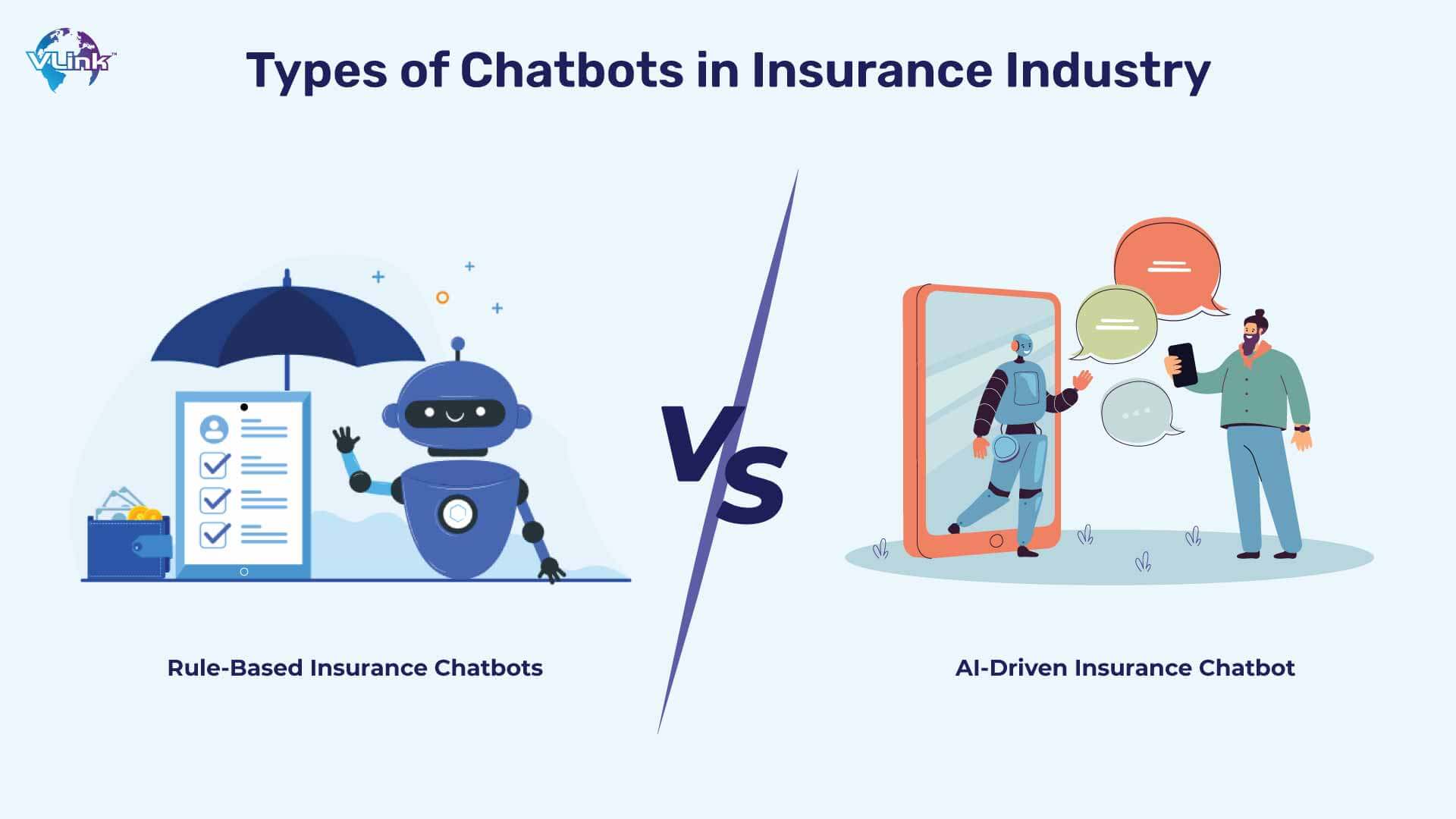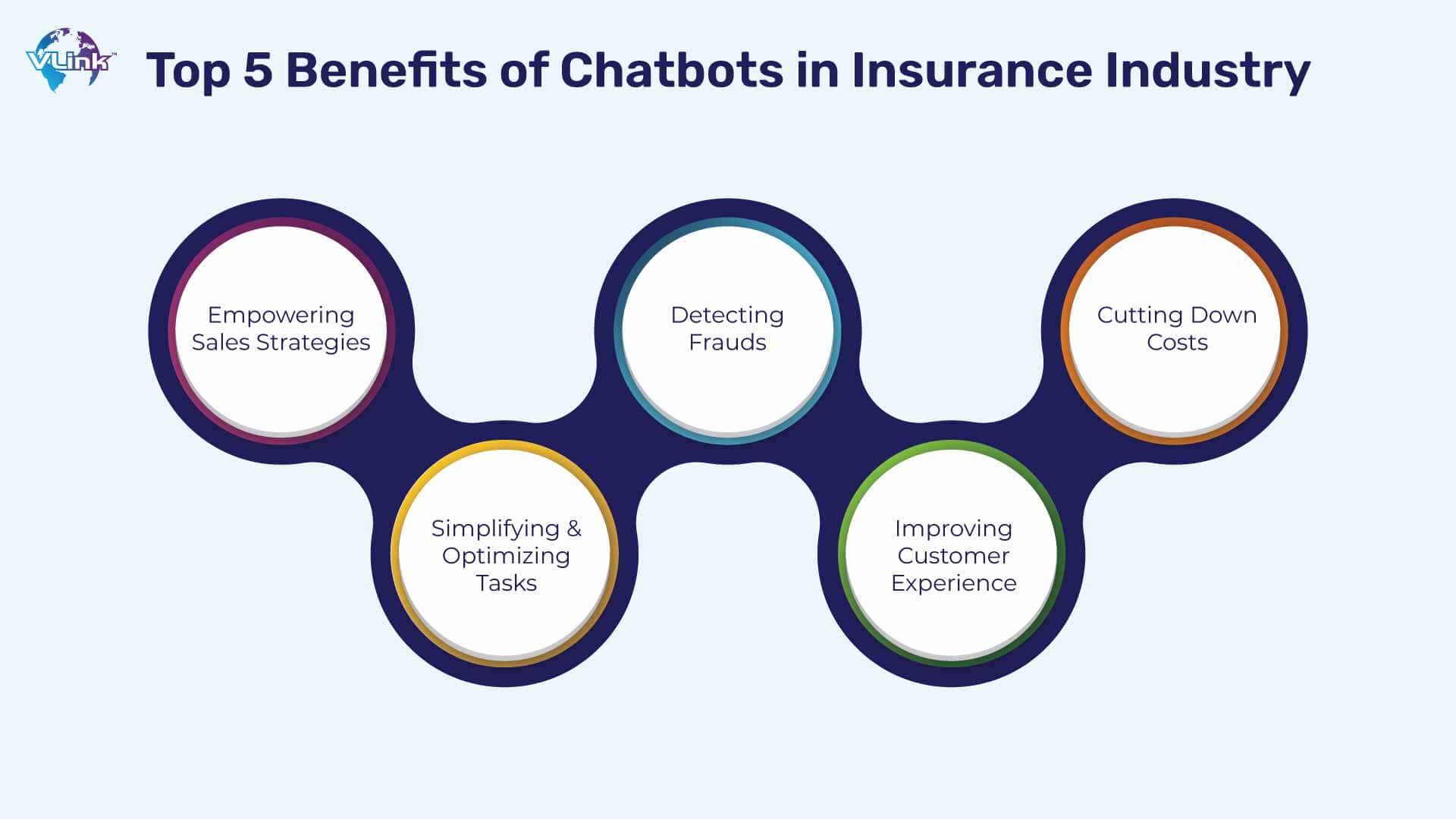Chatbot interactions have a higher satisfaction rate – around 87.58% – than live chats with humans.
This is certainly because chatbots are easier to deploy.
As a result, insurance companies are replacing live customer service agents with bots, saving money, and improving their efficiency.
Not only can bots provide information, but they can also gather details to facilitate the claims process.
Let us dive in and understand more of such reasons behind the rise of chatbots in insurance industry!
Understanding the Role of Chatbot in Insurance Industry
Chatbot is a virtual assistant which is designed to simplify and make the interaction between the insurance provider and its client more accessible and user-friendly. Such personal or digital assistants are changing the insurance services by proposing the most optimal, tailored, and constantly available communication options.
Some top benefits of chatbots in insurance industry are that they improve customer service, optimize several routine tasks, and most importantly, boost efficiency. From offering instant support, answering FAQs, and assisting claims processing to providing customized recommendations of policies, chatbots take care of literally everything that usually takes up a lot of time for companies.
According to Allied Market Research, the global insurance chatbot market was valued at USD 467.4 million in 2022, and is projected to reach USD 4.5 billion by 2032, growing at a CAGR of 25.5% from 2023 to 2032.
In essence, insurance chatbots are here to stay as it is a key innovation for insurance companies to provide a more personalized and engaging experience to their end customers.
Types of Chatbots in Insurance Industry

There are mainly two types of chatbots in insurance industry, which are as follows:
Rule-Based Insurance Chatbots
Insurance-based chatbots are rule-based bots. It is programmed with rules and specific workflows. It is designed to understand predefined commands and queries and respond accordingly to predefined scenarios.
They manage common tasks including FAQ answering, explaining policy to the customers, or starting the claim processes.
Rule-based insurance chatbots make sure reliable communication through their predictable and standardized responses based on common queries by the customers.
AI-Driven Insurance Chatbots
Another major advancement in chatbot technology is AI chatbot. Rather than rule-based chatbots, these use Artificial Intelligence to comprehend when responding to a wider variety of interactions. These chatbots are designed to understand human conversation, including contextual clues, intent, and even sentiment. In simpler words, these are AI-enabled chatbots for customer management.
Insurance chatbots, whether rule-based or driven by AI (Artificial Intelligence), are instrumental in insurance sector transformation. They combine efficiency, accuracy, and consumer-centric features, redefining how insurance businesses engage with their clients. The increasing reliance of the insurance industry on digital technology suggests that these chatbots will become more common, linking all parties in an insured and connected insurance environment.
Top 5 Benefits of Chatbots in Insurance Industry

Here is why the reliance of chatbots are increasing in the industrial insurance industry:
Empowering Sales Strategies
In today’s business world, every business should take strategic and innovative moves to stay ahead of the curve. That being said, here is how chatbots can empower an insurance company’s sales strategies:
- Lead Generation
What if you had a virtual assistant who started conversations with your prospects and nurtured them gently down your sales funnel? That is what a chatbot exactly does.
According to Tidio, 17 percent of businesses want to acquire their marketing & lead generation goals using chatbots.
These software applications take matters into their virtual hands, contacting your leads, answering their questions, and ensuring that all is handled professionally during your client journey.
- Product Insights
Knowledge holds much power in the insurance business. Chatbots are invaluable sources of intelligence, providing accurate information about available insurance products within mere seconds. This way, clients can immediately decide whether they want to buy from you or not.
- Lead Qualification
Efficiency is vital when it comes to qualifying leads! Now, chatbots are not only conversational; they are intelligent. They consolidate vital lead information in a structured way, allowing your sales team to optimize its approach. Armed with data, your sales team will be at peak efficiency, narrowing their outreach to leads with the highest probability of conversion.
- Upselling & Cross Selling
Long gone are the days of one-size-fits-all approaches. Indeed, chatbots use the data of each customer to recommend insurance policies that are particularly well-suited to their needs.
Given this unique feature, many providers get the upselling and cross-selling possibilities with this technology. In short, the chances of obtaining add-on sales and customer trust from individualized suggestions can be multiplied.
- More Conversions
Needless to say, following up on leads and existing customers is another critical area of insurance sales. Again, chatbots are perfect for this task.
According to Intercom, 35 percent of business leaders stated that virtual agents made it easier to close sales deals.
This is certainly because chatbots handle the routine follow-up tasks by sending reminders about policy details, renewals with perfect precision and timing. Thus, lead conversion is boosted, and customers continue doing business with you for longer. They like your high-quality service and will stick around.
Simplifying & Optimizing Tasks
Insurance chatbots are also revolutionizing the critical operations of insurance companies, making all their processes more customer centric. Here is how:
- Claims Management
Chatbots are good at helping customers navigate their way through the claims process and gathering information. The result is a faster and more transparent resolution to claims. This certainly means no more long waiting periods or confusing forms — chatbots manage and locate help for your clients when they need it the most.
- Data-Backed Process
Data and analytics are empowering every industry. Even the manufacturing industry is being innovated by data & analytics.
Insurance companies too require data to function and chatbots are expert when it comes to collecting data. Besides the data collected through customer interactions, they also analyze the same. Companies are thereby able to discern trends, bottlenecks in their processes, and areas requiring optimization. In essence, chatbots enable you to evolve your operations based on analytics.
- Information Delivery
Customers want to receive everything instantly, including insurance questions. Chatbots are the source of fast info delivery. Available 24 hours a day, they offer instant answers that enable rapid access to policy information, claims status, and other general questions. As a result, working with your company becomes faster and more convenient for customers.
According to MIT Technology Review, 90 percent of businesses report significant improvements in the speed of complaint resolution.
- Consistent Service Delivery
In the insurance industry, accuracy and consistency are everything. Chatbots can help guarantee that a consistent level of service is achieved by supplying customers with information/data that is precise, timely, and consistent.
Chatbots keep errors at bay. This helps to increase the reputation of your organization as a reliable, trustworthy, and responsible business.
Detecting Frauds
Identifying frauds and addressing them are the most difficult tasks for the insurance industry. Fortunately, chatbots help with fraud detection as well. Here is how:
- Customer Verification
It is safe to say that identity verification is more crucial than anything else in the insurance industry. Chatbots are extremely helpful in verifying customer identity. It is a great way to avoid possible identity fraud with policyholders. Thanks to the implemented checks, chatbots can be utilized as the first line of defense for fake claims.
- Claim Investigation
Claims investigations are a time-consuming as well as labor-intensive process. This is when Chatbots comes into the picture. They enable human fraud investigators by delivering unique data and insights. This process swiftly turns around claims' investigation, reduces claim leakage, and identifies as well as addresses fraudulent claims.
- Constant Surveillance
Fraudsters' activities are evolving, so one must keep eyes open by relying on bots. Chatbots work 24/7. Chatbots have eyes on customer conversations and activity surveillance all the time. They can spot anything suspicious instantly. This means, insurance companies can determine when to magnify activities or control risks regarding their behaviors.
- Fraud Database Integration
Chatbots are one step ahead in maintaining fraudsters at bay, thanks to their integration with fraudulent databases. They cross-refer customer information with claims data, boosting fraud detection. By preventing recognized fraudsters as well as improving underwriting’s reliability, fraud remains hard to get into any process during execution.
Improving Customer Experience
According to Yellow.ai, 80 percent of financial institutions consider chatbots as a valuable tool to improve their client service. Let us understand the reasons behind this:
- Risk Management
Insurance is all about managing risks and chatbots do it better. They always keep risk factors in check—thanks to their predictive analytics tools. Chatbots immediately instruct policyholders on how to manage risks and send real-time notifications. Consequently, clients can act immediately to protect their interests.
- Multilingual Support
In a globalized world, language and communication channels should never be a restricting factor. Chatbots resolve this issue for the users. They can speak to people in different languages to make sure accessibility and convenience to everyone.
- Emotion-Responsive Customer Care
Knowing the customer’s mood is essential for providing outstanding service. In this aspect, chatbots are irreplaceable, as they are equipped with identification signals, intending to capture the feeling of the customer during the conversation. The feature mainly gives bots a competitive advantage in their responses. They become more personal and sensitive to the tone of the client, proving the sense of being heard and appreciated.
Cutting Down Costs
Chatbots help to save a significant amount of costs. These AI-based programs handle repetitive inquiries and requests so that human staff can concentrate on more complex issues. As a result, allocating resources more effectively minimizes operational costs.
Future of Chatbots in Insurance Industry
According to MarketsandMarkets, the global chatbot market size was valued at USD 4.7 billion in 2022. The market is expected to grow from USD 5.4 billion in 2023 to USD 15.5 billion in 2028, exhibiting a CAGR of 23.3 percent during the forecast period.
Chatbots are the future of the insurance industry, improving customer support and easing workflow.
Over time, natural language parsing, and machine learning will make it easier for AI-powered bots to process data and elaborate on the answers more humanely – and eventually replace humans in some areas. But it is high time that the insurance industry staff should stop seeing automation as a threat.
In addition to this, they will be critical for personalized recommendations and proactive risk management, all of which will improve customer satisfaction and retention. Consequently, as technology advances, chatbots will also blend with other digital platforms for a more coherent and efficient customer engagement in the insurance industry.
Get Chatbot Integration Solutions for Your Insurance Company with VLink
Yes, you can rely on VLink . We will help you enhance your customer experience by integrating the chatbot with your existing systems, thereby optimizing your data accessibility and response accuracy.
Why wait? Take a step ahead and get in touch with our team to ensure continuous assistance to your customers.
Frequently Asked Questions
It helps companies evaluate risk, identify fraud, and minimize human input into the application process errors. AI is fundamentally reshaping the insurance industry by harnessing automation, enhancing claims, or creating efficient customer interaction models.
Mia chatbot, which was developed by German insurance company VHV Versicherungen was the very first insurance chatbot.
In the insurance industry, the major function of chatbot is the streamlining of insurance claims process. Chatbot accelerates the processing of claims—a process that has traditionally been extremely slow and laborious. They can instantly gather required facts, help clients fill out the forms, and keep them updated on the claims status as soon as they are submitted.
AI in insurance has a bright future. It will transform underwriting, claims processing, and risk assessment by utilizing data analytics and machine learning. AI will improve customer experience, operational efficiency, and risk mitigation with much higher precision than human intelligence capacity. Plus, ethical aspects and state regulatory policies will also significantly shape this technology.








